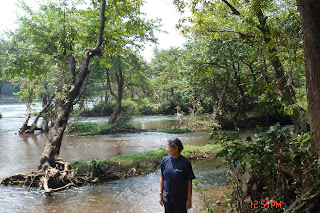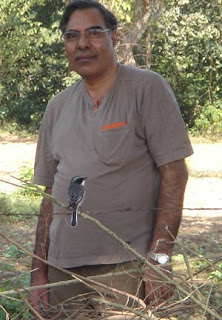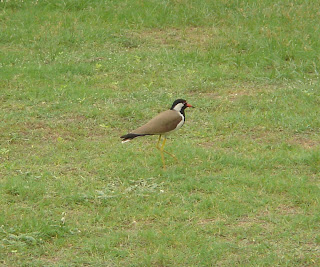Posted by
Susan Sharma
on
November 10, 2009

A visit to Kerala is never complete without a peek into the deep forests the State can still be proud off. Waiting nearly two hours to get permission to drive through the Illithod Mahagony Forest was forgotten once our vehicle entered this near pristine
forest. Till recently, we were told, the access to the forest was unrestricted and the area was a favourite with plastic throwing tourists. The State forest department stepped in and went a step further. They managed a court stay on the Aquaduct which was
being constructed on the banks, parallel to the River Periyar. The completeion of this canal would have meant no access for the animals to the river. For now the animals are happy!
 candle flowers grow wild on the roadside
candle flowers grow wild on the roadside
 entrance to the mahagony forest
entrance to the mahagony forest
 canopy of mahagony leaves
canopy of mahagony leaves
 an enveloping tree trunk
an enveloping tree trunk
 Periyar River (300km long) flows through the dense forest floor.
Periyar River (300km long) flows through the dense forest floor.
 strangler figs
abound (thanks to abundant bird life) strangler figs
abound (thanks to abundant bird life)
 the mahagony
survives and grows, unstrangled! the mahagony
survives and grows, unstrangled!
|
Posted by
Susan Sharma
on
November 08, 2009

Kovalam beach is a favourite with tourists for swimming in the sea. There are coast guards around who keep a watchful eye. The beach is advertised as ’jelly fish Free’ on the various travel sites. So it was a surprise to find large number of purple jellyfish
being washed onto the shore by the waves.

The coast guards assured us they are dead and harmless. The fishermen throw them out when they get caught in their nets. It seems there is a migration of jelly fish for about a fortnight in October, when the sea gets foamy with the gelatine in the jelly
fish. Kovalam beach never fails to arouse curiosity! Squids which made jelly fish their home, were seen crawling inside and attracted other beach goers. I am sharing a small clip uploaded in ’wildbytes’ channel of youtube.
|
Posted by
Susan Sharma
on
October 12, 2009
Economic governance: the organization of cooperation
Elinor Ostrom and Oliver Williamson win Nobel Prize for Economics 2009 on Monday.
http://news.cnpanyu.com/2009/1012/6856.html
Elinor Ostrom has challenged the conventional wisdom that common property is poorly managed and should be either regulated by central authorities or privatized. Based on numerous studies of user-managed fish stocks, pastures, woods, lakes, and groundwater
basins, Ostrom concludes that the outcomes are, more often than not, better than predicted by standard theories. She observes that resource users frequently develop sophisticated mechanisms for decision-making and rule enforcement to handle conflicts of interest,
and she characterizes the rules that promote successful outcomes.
|
Posted by
Susan Sharma
on
September 30, 2009

This year the rains came late and lingered till end of August. The butterflies and moth caterpillars waste no time in completing their life cycles; Here are some I managed capturing on the lens, in the beginning of September.
 The above picture is that of a lime butterfly caterpillar which is probably in its third stage (instar)of moulting. The picture below is that of the same caterpillar after two more moultings. Now it is in its last ’instar’ and the next stage will be the pupa
and then the lime butterfly. The host plant is the Chinese Orange tree.
The above picture is that of a lime butterfly caterpillar which is probably in its third stage (instar)of moulting. The picture below is that of the same caterpillar after two more moultings. Now it is in its last ’instar’ and the next stage will be the pupa
and then the lime butterfly. The host plant is the Chinese Orange tree.
 If the caterpillars of lime butterfly are fast eaters, they pale in comparison with the moth caterpillar’s eating capacity. The picture below is that of the Elephant Yam moth caterpillar. This one could devour huge leaves of the yam plant overnight and was
found hiding beneath the leaf during the day. I could not observe this caterpillar in its next stage; probably a mynah or babbler found this packaged fast food irresistible. The caterpillar disappeared sometime during the day.
If the caterpillars of lime butterfly are fast eaters, they pale in comparison with the moth caterpillar’s eating capacity. The picture below is that of the Elephant Yam moth caterpillar. This one could devour huge leaves of the yam plant overnight and was
found hiding beneath the leaf during the day. I could not observe this caterpillar in its next stage; probably a mynah or babbler found this packaged fast food irresistible. The caterpillar disappeared sometime during the day.

|
Posted by
Susan Sharma
on
September 26, 2009

I was in Kangra (Himachal Pradesh) late October, just before winter set in. As always, the countryside is ever changing and never fails to reveal something new for my camera to capture. The mongoose family scurrying about the neighbour’s vegetable fields
was amusing.
http://backyard-wildlife.wildbytes.in/#25
So was the sight of giant wood spiders alongside walking paths. The females are nearly ten times larger than the males, I believe. They weave the strongest and largest spiderwebs known to us. Shiny legs with yellow joints are their hallmark. Giant wood spiders
are the subject of research- Humans would love to know the secret of creating the strong golden websilk. "In modern times, the Golden Orb Web Spider’s silk is set to become a major product. The silk is almost as strong as Kevlar, the strongest man-made material
which is drawn from concentrated sulphuric acid. In contrast, spider silk is drawn from water. If we could manufacture spider silk, it would have a million uses from parachutes, bullet-proof vests, lightweight clothing, seatbelts, light but strong ropes, as
sutures in operations, artificial tendons and ligaments. Studies are now being done to have genetically engineered plants produce fluid polymers which can be processed into silk".
http://backyard-wildlife.wildbytes.in/#24
The wild red and white berries were all over.

The fields had spawned metallic mushrooms which vied with the pebbles lying around.

My husband was only too pleased to pose for a photo, framing a wagtail which he was pointing out to me!
 More on my next visit!
More on my next visit!
|
Posted by
Susan Sharma
on
September 26, 2009



The red wattled lapwing is a regular visitor to our neighbourhood park. So I was thrilled to see three spotted eggs on the ground on 5th June. The eggs were laid in the centre of the Park which sees morning walkers doing their rounds every day (who would
not notice the eggs anyway) and young children playing football and cricket in the evenings. To protect the eggs the bird had laid the eggs underneath a tree-guard.
On 9th June, I went to check on the eggs. There was no one in the Park. But I was delighted to see two small chicks with their mother. The mother noticed me as I was still at the gate and started alarm calls. The pitch went higher and higher as I tried to
go close. The chicks scampered in one direction while the mother went in another. Soon the father lapwing appeared on the scene and started shrieking. Then, an amazing thing happened. The chicks suddenly disappeared in the grass and made themselves invisible.
Almost simultaneously, sparrows and Indian robins started flying around the area even as the parent lapwings held on to their spots.
I was mesmerised by this amazing act of community feeling! Needless to say I had to return without a photo. I could not help but feel moved enough to write this blog!
|
Posted by
Susan Sharma
on
September 17, 2009

Sunderbans of West Bengal in India
Sunderbans is the world’s largest delta formed by the river Ganga. Sunderbans comprises 54 tiny lands at present and a number of tributaries of the river Ganga crisscross Sunderbans.
Ghoramara island in the Sunderbans is shrinking due to the rising sea-level. Ghoramara has shrunk from 9 square kilometres to 4.5 square kilometres in the past 30 years as rising sea level and constant erosion of embankment has already uprooted 7,000 inhabitants
leaving another 7,000 in a state of constant fear.
The biggest island, Sagar which hosted refugees from other islands all these years is witnessing massive erosion now. 70,000 people in the 9 sea-facing islands are at the edge of losing land in next 15 years. For these people climate change is real. “Mean
Sea Level”, a documentary made by CSE depicts the threat of erosion the island faces in the wake of rising water levels.
The Union ministry of environment and forests is reportedly preparing measures to protect Sunderbans, the largest mangrove block in the world. According to a report in
Business Standard, short-term and long-term measures for protecting the ecology of Sunderbans would have to be taken.
Venice, which rests on millions of wooden piles pounded into marshy ground, has sunk by about seven centimetres a century for the past 1,000 years.
(According to a study done in 2000 and reported by CNN)
The earth’s natural underground water supplies acted as a cushion that helped slow the city’s sinking.
Venice and its lagoon was added to UNESCO’s World Heritage list in 1987.
The Italian government is spending 4.5bn euro (£2.9bn) on a controversial project to build floodgates across the entrance to the lagoon in which the city stands in an effort to keep the sea at bay. http://travelphotolog.wildbytes.in/#5
|
Posted by
Susan Sharma
on
September 06, 2009
The following news item which appeared in The Hindu today, should make all of us sit up and take notice. Conservation is the most complex subject-It is only when environmentalists and the common man ( here the fishermen) sit together, can solutions
emerge. Otherwise the reactions are bound to be knee-jerk. Or at best imported from a situation elsewhere, where the realities might be very different.
http://www.hindu.com/2009/09/07/stories/2009090753550400.htm
|
Posted by
Susan Sharma
on
August 22, 2009
August 15, Independence Day- An ideal day to check out the hill station near to Chandigarh since we were already in Chandigarh on a visit.
The weather was good. It had rained for two days so the drive up was picturesque. We stopped the car many times just to take in the scenery. On the way we passed many other cars doing the same. Ha! this is like heaven after the hustle bustle of daily life.
Scenic view from nature camp. Double click on the photo and notice the blue water tank on the left.
 Read the full report at the link
Read the full report at the link
http://travelphotolog.blogspot.com
|
Posted by
Susan Sharma
on
August 20, 2009
Here is a visual journey of the total solar eclipse in New Delhi. The Nehruplanetarium at Teenmurti was surrounded by parked cars in hundreds well before 6 AM on 22nd July 2009. The Sun is about to rise and the video camera of an enthusiast or of some
TV channel is hoping to catch it first!
 Young and old alike are waiting for the solar spectacle to unfold.
Young and old alike are waiting for the solar spectacle to unfold.
 At 6.40 AM this is how the sun looked to the naked eye.
At 6.40 AM this is how the sun looked to the naked eye.
 But the screen put up on Teen Murti lawns showed a different picture!
But the screen put up on Teen Murti lawns showed a different picture!
 The secret was to cut out all other light by looking through the unexposed portion of an X-ray film. Some school girls were seen distributing the X-ray films to those who wanted them. Many were also looking through the X-ray film spectacles sold for the purpose.
I decided to put an X-ray film in front of the view finder of my digital camera. Here is what I saw. At 6.44 AM on 22nd July 2009
The secret was to cut out all other light by looking through the unexposed portion of an X-ray film. Some school girls were seen distributing the X-ray films to those who wanted them. Many were also looking through the X-ray film spectacles sold for the purpose.
I decided to put an X-ray film in front of the view finder of my digital camera. Here is what I saw. At 6.44 AM on 22nd July 2009
 At 7.19 AM on 22nd July 2009
At 7.19 AM on 22nd July 2009
 That was truly a "once in a life-time" experience!
That was truly a "once in a life-time" experience!
|